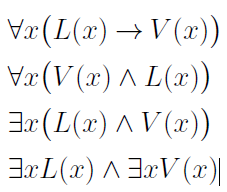Question
This is Discrete Mathematics Subject For the rest of this assignment, we'll be working with toy models for First-Order Logic formulas. In each model, the
This is Discrete Mathematics Subject
For the rest of this assignment, we'll be working with toy models for First-Order Logic formulas. In each model, the universe will be some set of letters. Some of the letters will be vowels (A, a, E, e, I, i, . . . ) and some will be consonants (B, b, D, d, F, f, G, g, . . . ) Some will be in uppercase (A, B, D, E, . . . ), and some will be in lowercase (a, b, d, e, . . . ). To avoid confusion, I'll try to avoid letters where it's hard to tell the difference between upper and lowercase, and you should do the same (e.g., don't use C or O or X). Also, for this assignment, we will treat Y as a vowel.
Use the following interpretations for the predicate symbols. V (x): x is a vowel. L(x): x is lowercase.
Using the same definitions as above, translate the following English sentences into formulas of First-Order Logic. (a) Every vowel is lowercase. (b) Some lowercase letter is a vowel. (c) All of the letters are lowercase vowels.
Using the same definitions as above, translate the following First-Order Logic formulas into natural-sounding English sentences. (In particular, you may not use variables in your answers.)

Step by Step Solution
There are 3 Steps involved in it
Step: 1

Get Instant Access to Expert-Tailored Solutions
See step-by-step solutions with expert insights and AI powered tools for academic success
Step: 2

Step: 3

Ace Your Homework with AI
Get the answers you need in no time with our AI-driven, step-by-step assistance
Get Started


